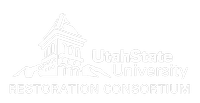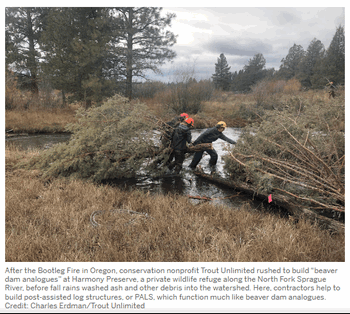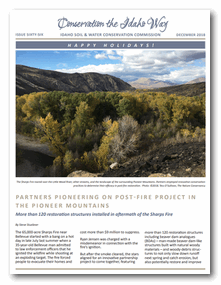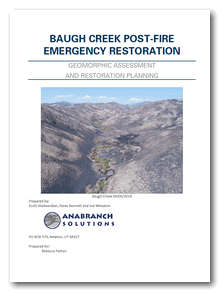Examples of LTPBR for Post Fire Recovery
North Fork Sprague River, Oregon → Bootleg Fire 2021
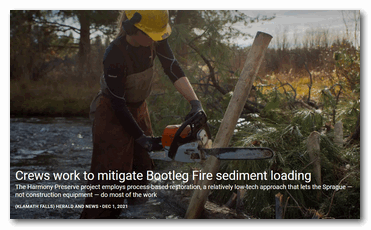 Crews work to mitigate Bootleg Fire sediment loading The Harmony Preserve project employs process-based restoration, a relatively low-tech approach that lets the Sprague — not construction equipment — do most of the work
Crews work to mitigate Bootleg Fire sediment loading The Harmony Preserve project employs process-based restoration, a relatively low-tech approach that lets the Sprague — not construction equipment — do most of the work
Project Information
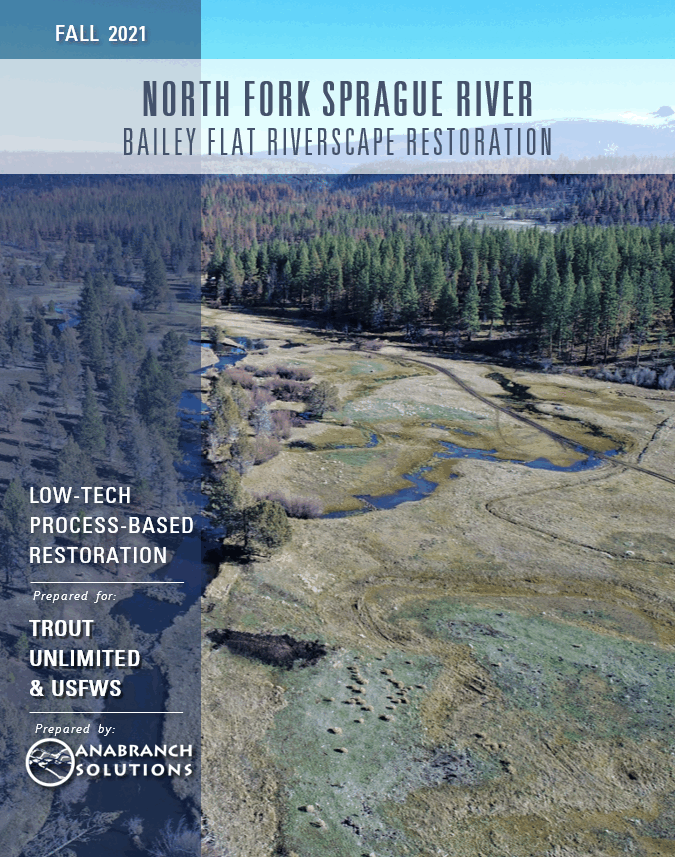 This was an emergency restoration project following the Bootleg Fire in July and August of 2021. The original meetings with land owners, USFWS and Trout Unlimmited staff were in late September of 2021. Planning, Design and Permits were in place by early November and Anabranch Solutions and Swift Water Design finished construction prior to Thanksgiving.
This was an emergency restoration project following the Bootleg Fire in July and August of 2021. The original meetings with land owners, USFWS and Trout Unlimmited staff were in late September of 2021. Planning, Design and Permits were in place by early November and Anabranch Solutions and Swift Water Design finished construction prior to Thanksgiving.
Media Coverage
- Whitcomb 2022. Beaver Dams Help Wildfire-Ravaged Ecosystems Recover Long after Flames Subside - Dams mop up debris that would otherwise kill fish and other downstream wildlife, new observations suggest Scientific American. February 7, 2022.
- Schwartz 2021. Crews work to mitigate Bootleg Fire sediment loading. Klamath Falls Herald & News Dec 1, 20221
Project Tweets
Great article by @IsobelWhitcomb highlighting work done by beaver and #lowtechPBR by @TroutUnlimited, @USFWS, local partners and @AnabranchS in Southern Oregon. Beaver Dams Help Wildfire-Ravaged Ecosystems Recover Long after Flames Subside https://t.co/qrP7Drudnz via @sciam
— Joe Wheaton (@fluvialwheaton) February 10, 2022
Baugh Creek, Idaho → Sharps Fire 2018
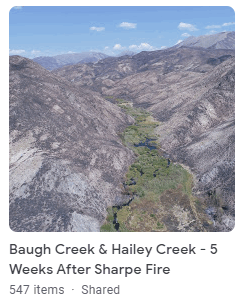 The Sharps Fire, 2018 was where the fairly obvious tweet below came from (i.e. “turns out water does not burn” - see related Tweets
). ,Interestingly on the heels of a NRCS LTPBR Workshop in Hailey, Idaho, we were in discussions with Idaho Fish and Game about a potential LTPBR project to expand the footprint of beaver in Baugh Creek. Terry Gregory (IDFG) had for the previous two decades translocated live beaver from irrigation ditches up to Baugh Creek to do restoration work. Thanks to the efforts of Terry, the beaver he reintroduced, and their offspring we see the resilience to thee fire illustrated in the picture below.
The Sharps Fire, 2018 was where the fairly obvious tweet below came from (i.e. “turns out water does not burn” - see related Tweets
). ,Interestingly on the heels of a NRCS LTPBR Workshop in Hailey, Idaho, we were in discussions with Idaho Fish and Game about a potential LTPBR project to expand the footprint of beaver in Baugh Creek. Terry Gregory (IDFG) had for the previous two decades translocated live beaver from irrigation ditches up to Baugh Creek to do restoration work. Thanks to the efforts of Terry, the beaver he reintroduced, and their offspring we see the resilience to thee fire illustrated in the picture below.
Looking for Album? For media outlets, authors and individuals looking to use these images, you may use any of the images in this album at no cost. Joe Wheaton has licensed everything in the album has a Creative Commons Attribution license, so you can use the images in your own works..
Why is there an impressive patch of green in the middle of 65,000 acres of charcoal? Turns out water doesn't burn. Thank you beaver! More than just a #lowtechPBR tool... 🔥 resilience! pic.twitter.com/thdyztJQOs
— Joe Wheaton (@fluvialwheaton) September 6, 2018
From LCAN - “Conservation professionals turned a negative into a positive in the aftermath of the 65,000-acre Sharps wildfire on Baugh Creek in the Little Wood watershed in Central Idaho. A major partnership project led by the Idaho Soil and Water Conservation Commission led to the installation of more than 120 beaver dam-type low-tech structures along Baugh Creek and two other tributaries to help restore the streams in a post-fire environment. The beaver dam analogs and other woody in-stream structures slow down the water flow, increase meanders and store water high in the watershed for the benefit of fish, wildlife and livestock.
The project was made possible by two private landowners in the area that wanted to restore the streams and improve wildlife habitat. Partners included Idaho Fish and Game, Trout Unlimited, U.S. Fish and Wildlife Service, Wood River Land Trust, The Nature Conservancy, Anabranch Solutions, Utah State University, and more.”
Media Coverage
- Stuebner S. 2018. Idaho Soil & Water Conservaton Commission - “Partners Pioneering on Post-Fire Project in the the Pioneer Mountains” Conservation the Idaho Way. Idaho Soil & Water Conservation Commission.
- Goldfarb, B. 2020. How beavers became North America’s best firefighter. National Geographic.
- Randall, B. 2018. Beavers, Water, and Fire—A New Formula for Success Low-tech stream restoration works wonders for people and wildlife. National Wildlife Federation Blog.
Great job @BriannaRandall from @SageGrouseInit getting this story about interplay between fire, beaver and resilience out! Hats off to our visionary partners @idfg, @USFWS, @BLMUtah, and @usfs_r4.
— Joe Wheaton (@fluvialwheaton) October 30, 2018
Beavers, Water, and Fire—A New Formula for Success https://t.co/nzMTEv6ou5
Project Reports
- Shahverdian SM and Wheaton JM. 2018. Baugh Creek Post-Fire Emergency Restoration – Design and Implementation Report. Prepared for Rebecca Patton by Anabranch Solutions, LLC. Newton, UT. 31 pp. DOI: 10.13140/RG.2.2.14182.27209
- Shahverdian SM, Bennett SN, and Wheaton JM. 2018. Baugh Creek Post-Fire Emergency Restoration – Prioritizing and Planning Post-Fire Restoration in the Baugh Creek Watershed. Prepared for Rebecca Patton by Anabranch Solutions, LLC. Newton, UT. 26 pp. DOI: 10.13140/RG.2.2.17537.71528
Baugh Creek Images Appear In
The images from the Baugh Creek Album appear in the following scholarly outlets:
- Endter-Wada J, Kettenring KM, Sutton-Grier A. 2020. Protecting wetlands for people: Strategic policy action can help wetlands mitigate risks and enhance resilience. Environmental Science & Policy 108 : 37–44. DOI: 10.1016/j.envsci.2020.01.016
- Wheaton, J.M., Bennett, S.N., Bouwes, N., Camp, R., Maestas, J.D. and Shahverdian, S.M. 2019. Chapter 2 – Principles of Low-Tech Process-Based Restoration. In: J.M. Wheaton, S.N. Bennett, N. Bouwes, J.D. Maestas and S.M. Shahverdian (Editors), Low-Tech Process-Based Restoration of Riverscapes: Design Manual. Utah State University Wheaton Restoration Consortium, Logan, Utah. 30 pp. DOI: 10.13140/RG.2.2.34270.69447
Goose Creek, Nevada/Utah
Goose Creek Fire - BLM and Utah WRI
- Goose Creek Fire Rehabilitation
- Goose Creek Fire Stream Restoration - Phase 1
- Goose Creek Fire Stream Restoration - Phase 2

